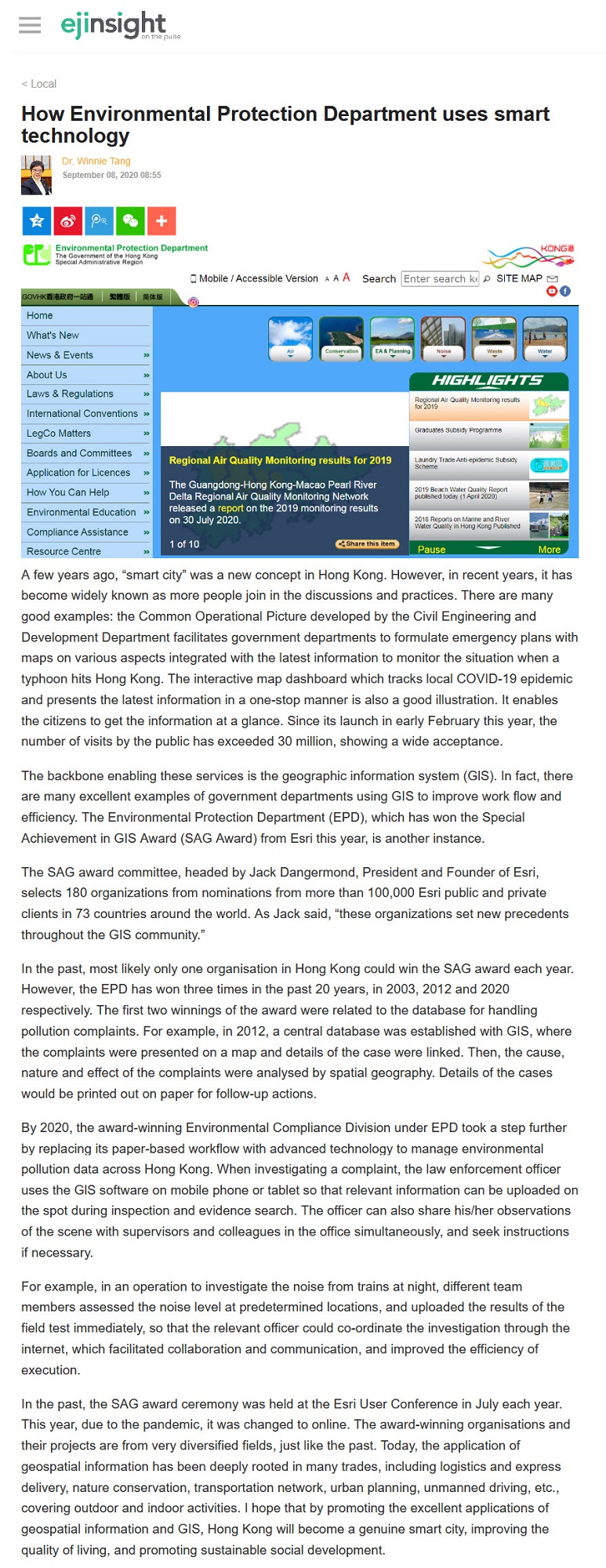網上版請按此

How Environmental Protection Department uses smart technology
A few years ago, "smart city" was a new concept in Hong Kong. However, in recent years, it has become widely known as more people join in the discussions and practices. There are many good examples: the Common Operational Picture developed by the Civil Engineering and Development Department facilitates government departments to formulate emergency plans with maps on various aspects integrated with the latest information to monitor the situation when a typhoon hits Hong Kong. The interactive map dashboard which tracks local COVID-19 epidemic and presents the latest information in a one-stop manner is also a good illustration. It enables the citizens to get the information at a glance. Since its launch in early February this year, the number of visits by the public has exceeded 30 million, showing a wide acceptance.
The backbone enabling these services is the geographic information system (GlS). In fact, there are many excellent examples of government departments using GIS to improve work flow and efficiency. The Environmental Protection Department (EPD), which has won the Special Achievement in GIS Award (SAG Award) from Esri this year, is another instance.
The SAG award committee, headed by Jack Dangermond, President and Founder of Esri, selects 180 organizations from nominations from more than 100,000 Esri public and private clients in 73 countries around the world. As Jack said, "these organizations set new precedents throughout the GIS community."
In the past, most likely only one organisation in Hong Kong could win the SAG award each year. However, the EPD has won three times in the past 20 years, in 2003, 2012 and 2020 respectively. The first two winnings of the award were related to the database for handling pollution complaints. For example, in 2012, a central database was established with GIS, where the complaints were presented on a map and details of the case were linked. Then, the cause, nature and effect of the complaints were analysed by spatial geography. Details of the cases would be printed out on paper for follow-up actions.
By 2020, the award-winning Environmental Compliance Division under EPD took a step further by replacing its paper-based workflow with advanced technology to manage environmental pollution data across Hong Kong. When investigating a complaint, the law enforcement officer uses the GlS software on mobile phone or tablet so that relevant information can be uploaded on the spot during inspection and evidence search. The officer can also share his/her observations of the scene with supervisors and colleagues in the office simultaneously, and seek instructions if necessary.
For example, in an operation to investigate the noise from trains at night, different team members assessed the noise level at predetermined locations, and uploaded the results of the field test immediately, so that the relevant officer could co-ordinate the investigation through the internet, which facilitated collaboration and communication, and improved the efficiency of execution.
In the past, the SAG award ceremony was held at the Esri User Conference in July each year. This year, due to the pandemic, it was changed to online. The award-winning organisations and their projects are from very diversified fields, just like the past. Today, the application of geospatial information has been deeply rooted in many trades, including logistics and express delivery, nature conservation, transportation network, urban planning, unmanned driving, etc., covering outdoor and indoor activities. I hope that by promoting the excellent applications of geospatial information and GIS, Hong Kong will become a genuine smart city, improving the quality of living, and promoting sustainable social development.
Dr. Winnie Tang
Adjunct Professor, Department of Geography, Faculty of Social Sciences and Faculty of Architecture, The University of Hong Kong